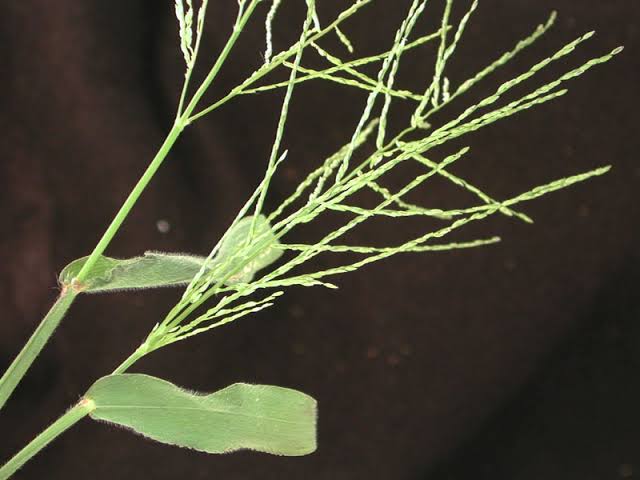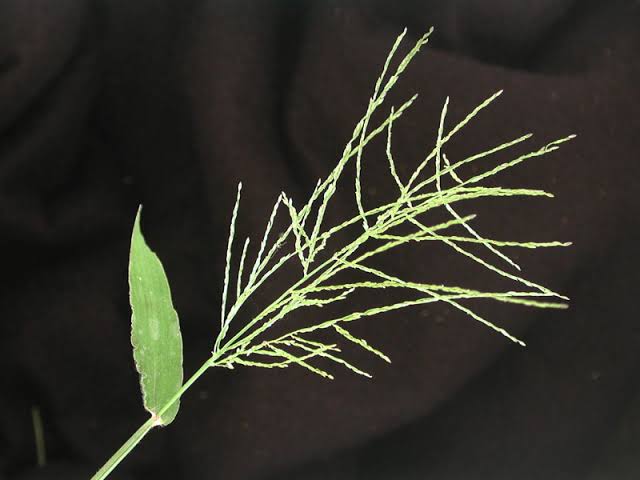Velvet fingergrass (Digitaria velutina) is a type of grass that grows in many places around the world. It is a special kind of grass because it feels soft like velvet when you touch it. This makes it stand out from other types of grass.
One interesting thing about Velvet fingergrass is its appearance. The leaves of this grass are slender and can vary in color, ranging from green to brown. These leaves grow close to the ground, forming a dense and lush carpet of softness. People often enjoy the comforting sensation of running their fingers through this grass.
This grass is not only pleasant to touch but also serves important purposes in nature. Velvet fingergrass plays a role in providing habitat for small creatures like insects and worms. It creates a cozy home for them to live in, making it an essential part of the ecosystem.
In addition to its role in nature, Velvet fingergrass has been used by people in various ways. Some communities use it for traditional practices, while others appreciate its beauty in gardens and landscapes. Its adaptability to different climates and soils makes it a versatile choice for landscaping projects.
One remarkable feature of Velvet fingergrass is its resilience. It can withstand different weather conditions, making it a hardy plant that can thrive in various environments. This adaptability contributes to its widespread presence in different parts of the world.
In addition, Velvet fingergrass, scientifically known as Digitaria velutina, is a unique and versatile grass that adds a touch of softness and beauty to nature. Its velvety texture, coupled with its ecological significance and adaptability, makes it a noteworthy element in both natural ecosystems and human landscapes. Whether enjoyed for its tactile appeal or utilized for practical purposes, Velvet fingergrass continues to be an interesting and valuable part of our natural surroundings.
Read Also: How to Grow and Care for Grapes
How To Grow Velvet Fingergrass (Digitaria velutina)

Growing Velvet fingergrass (Digitaria velutina) can be a straightforward and rewarding process. Here are some simple steps to help you cultivate this unique grass:
1. Select a Suitable Location: Choose a sunny or partially shaded area for planting Velvet fingergrass. This grass tends to thrive in well-draining soil.
2. Prepare the Soil: Ensure the soil is loose and well-draining. You can improve the soil by adding organic matter such as compost. This helps create a favorable environment for Velvet fingergrass to establish itself.
3. Planting Seeds: Sow Velvet fingergrass seeds directly into the prepared soil. Scatter the seeds evenly and lightly press them into the soil surface. Water the area gently to settle the seeds.
4. Watering: Keep the soil consistently moist until the grass is established. Once the Velvet fingergrass is growing well, it is generally drought-tolerant, but regular watering can promote healthier growth.
5. Fertilization: While Velvet fingergrass is not particularly demanding when it comes to nutrients, you can apply a balanced fertilizer during the growing season to encourage lush and vibrant growth.
5. Pruning and Maintenance: Periodically trim or mow the Velvet fingergrass to maintain its desired height. This can help keep the grass healthy and prevent it from becoming too tall and unkempt.
6. Pest and Disease Control: Keep an eye out for pests or diseases that may affect Velvet fingergrass. While this grass is generally hardy, routine checks can help you address any issues promptly.
7. Propagation: If you want to expand your Velvet fingergrass area, you can collect seeds from mature plants and sow them in new locations following the same planting process.
8. Winter Care: In colder climates, Velvet fingergrass may go dormant in winter. If you experience frost, mulching the area can provide some protection.
9. Enjoy the Velvet Touch: Once your Velvet fingergrass has established itself, take the time to appreciate its velvety texture. Run your fingers through the grass and enjoy the unique softness it brings to your outdoor space.
By following these simple steps, you can successfully grow Velvet fingergrass and enhance your garden or landscape with this distinctive and touchable grass.
How To Care For Velvet Fingergrass (Digitaria velutina)
Caring for Velvet fingergrass (Digitaria velutina) involves a few key considerations to ensure its health and vibrancy. Here’s a guide to help you care for this unique grass:
1. Watering: Velvet fingergrass is generally drought-tolerant once established, but regular watering is essential during dry periods. Water deeply to encourage deep root growth. Avoid overwatering, as this grass prefers well-draining soil.
2. Pruning and Mowing: Periodically trim or mow Velvet fingergrass to maintain its desired height and prevent it from becoming too tall and floppy. Regular pruning can also help remove any dead or yellowing foliage.
3. Fertilization: While Velvet fingergrass is not overly demanding in terms of nutrients, you can apply a balanced fertilizer in the growing season to promote healthy growth. Follow the recommended application rates on the fertilizer package.
4. Weeding: Keep the area around Velvet fingergrass free from weeds. Weeds can compete for nutrients and water, potentially affecting the health of the grass. Regular weeding helps maintain a clean and healthy growing environment.
5. Pest and Disease Management: Monitor the grass for any signs of pests or diseases. While Velvet fingergrass is generally resilient, it’s essential to address any issues promptly. Consider natural or organic methods of pest control if needed.
6. Winter Care: In colder climates, Velvet fingergrass may go dormant in winter. If you experience frost, consider applying a layer of mulch around the base of the grass to provide some insulation and protect it during colder months.
7. Division and Propagation: Over time, Velvet fingergrass may benefit from division to rejuvenate its growth. You can divide mature clumps and replant them in suitable locations. This process helps maintain the health and vigor of the grass.
8. Monitor Sunlight Exposure: Ensure that Velvet fingergrass receives the appropriate amount of sunlight. While it can tolerate partial shade, providing sufficient sunlight will contribute to its overall well-being.
9. Regular Inspection: Periodically inspect the Velvet fingergrass for any signs of stress, discoloration, or irregular growth. Early detection of issues allows for timely intervention and ensures the continued health of the grass.
10. Appreciate the Texture: Take the time to enjoy the velvety texture of Velvet fingergrass. Gently run your fingers through the grass and appreciate the unique softness it brings to your outdoor space.
By incorporating these care practices into your routine, you can maintain a healthy and thriving Velvet fingergrass, enhancing the beauty of your garden or landscape.
Read Also: Importance and Different Uses of Oranges
The Uses of Velvet Fingergrass (Digitaria velutina)

Velvet fingergrass (Digitaria velutina) has several uses, both practical and aesthetic, making it a versatile and valuable plant. Here are some of its notable uses:
1. Landscaping: Velvet fingergrass is often used in landscaping to add texture and visual interest to gardens, lawns, and outdoor spaces. Its unique velvety texture sets it apart, creating a soft and lush appearance.
2. Erosion Control: Due to its dense growth habit, Velvet fingergrass is effective for controlling soil erosion. Planting this grass on slopes or areas prone to erosion helps stabilize the soil and prevent runoff.
3. Habitat for Wildlife: The dense foliage of Velvet fingergrass provides a habitat for small wildlife, including insects and worms. It contributes to biodiversity by creating a sheltered environment for these creatures.
4. Ground Cover: With its low-growing and spreading nature, Velvet fingergrass serves as an excellent ground cover. It forms a thick carpet that suppresses weed growth and adds a green touch to the ground.
5. Traditional Uses: In some regions, communities may have traditional uses for Velvet fingergrass. This could include weaving or crafting purposes, utilizing the grass for practical or cultural applications.
6. Drought Tolerance: Velvet fingergrass is known for its ability to tolerate drought conditions once established. In regions with water scarcity, this grass can be a practical choice for maintaining green spaces with minimal water input.
7. Soil Improvement: As a grass species, Velvet fingergrass contributes to soil health by preventing soil compaction and promoting aeration. Its root system enhances soil structure, making it more conducive to other plant growth.
8. Aesthetic Appeal: Beyond its practical uses, Velvet fingergrass adds aesthetic appeal to various settings. Whether in residential gardens, public parks, or commercial landscapes, its soft and velvety texture creates a pleasing visual effect.
9. Adaptable to Various Climates: Velvet fingergrass shows adaptability to different climates and soil types, making it a versatile choice for landscaping projects in diverse geographic regions.
10. Educational Purposes: Velvet fingergrass can be used for educational purposes, especially in botanical or environmental studies. It provides an opportunity for students and researchers to observe the characteristics and behavior of this particular grass species.
Overall, Velvet fingergrass proves to be a multifaceted plant with uses ranging from erosion control and wildlife habitat creation to enhancing the visual appeal of outdoor spaces. Its adaptability and unique qualities make it a valuable asset in various contexts.
Frequently Asked Questions (FAQs)
Q: What is Velvet fingergrass (Digitaria velutina)?
A: Velvet fingergrass, scientifically known as Digitaria velutina, is a type of grass known for its distinctive velvety texture. It is often used in landscaping, providing both aesthetic appeal and practical benefits.
Q: Where does Velvet fingergrass grow?
A: Velvet fingergrass is adaptable and can be found in various regions around the world. It tends to thrive in sunny to partially shaded areas with well-draining soil.
Q: How do I grow Velvet fingergrass?
A: To grow Velvet fingergrass, choose a suitable location with well-draining soil, plant the seeds directly, water regularly until established, and provide periodic pruning. It is generally a hardy grass with minimal care requirements.
Q: Is Velvet fingergrass drought-tolerant?
A: Yes, Velvet fingergrass is known for its ability to tolerate drought conditions once it has established itself. However, regular watering during dry periods is still beneficial.
Q: Can Velvet fingergrass be used for erosion control?
A: Yes, Velvet fingergrass is effective for controlling soil erosion due to its dense growth habit. Planting it on slopes or erosion-prone areas helps stabilize the soil.
Q: What are the traditional uses of Velvet fingergrass?
A: In some regions, communities may have traditional uses for Velvet fingergrass, such as for weaving or crafting purposes. The grass may have practical or cultural significance in these contexts.
Q: Does Velvet fingergrass attract wildlife?
A: Yes, the dense foliage of Velvet fingergrass provides habitat for small wildlife, including insects and worms. It contributes to biodiversity by creating a sheltered environment.
Q: How do I care for Velvet fingergrass?
A: Care for Velvet fingergrass by providing regular watering, occasional pruning, well-draining soil, and monitoring for pests or diseases. It is a relatively low-maintenance grass once established.
Q: Can Velvet fingergrass grow in different climates?
A: Yes, Velvet fingergrass is adaptable to various climates and soil types, making it a versatile choice for landscaping projects in different geographic regions.
Q: What is the winter care for Velvet fingergrass?
A: In colder climates, Velvet fingergrass may go dormant in winter. Applying a layer of mulch around the base can provide some insulation and protect it during colder months.
Read Also: How to Grow Tomatoes in Containers
